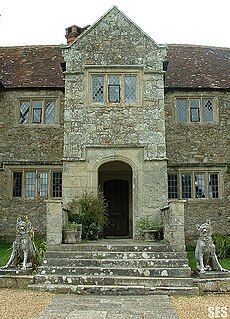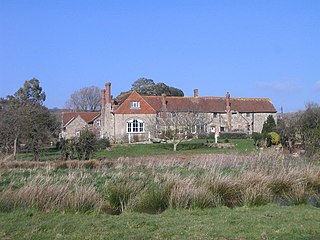Perreton Manor (also Peryton, 16th century) is a manor house on the Isle of Wight, situated in the parish of Arreton.

The Isle of Wight is a county and the largest and second-most populous island in England. It is in the English Channel, between 2 and 5 miles off the coast of Hampshire, separated by the Solent. The island has resorts that have been holiday destinations since Victorian times, and is known for its mild climate, coastal scenery, and verdant landscape of fields, downland and chines.

Arreton is a village and civil parish in the central eastern part of the Isle of Wight, England. It is about 3 miles south east of Newport.
A member of Arreton Manor, it belonged at the Dissolution to the Quarr Abbey. [1] A messuage called Perreton was granted in 1545 to Anthony Beyff, and in 1591–2 it was granted to John Welles. It comprises the land between Arreton and Redway, and a field to the west of the road leading from Croucher's Cross to Arreton is called Old Perreton and pointed out as the traditional site of the house. The present house lies in the low ground and is of the ordinary farm type of the 17th century. [1] It has a date stone, L.B. 1668, the initials of Levinus Bennet. [1]

Arreton Manor is a manor house in Arreton, Isle of Wight, England. Its history is traced to 872 AD to the time of King Alfred the Great and his parents. It was left by King Alfred by his will to his youngest son Aethelweard. Once owned by William the Conqueror, as mentioned in the Domesday Book in 1086, in the 12th century it became part of Quarr Abbey and was used by the monks for over 400 years. In 1525 it was leased to the Leigh family. The manor was rebuilt between 1595 and 1612. Built in Jacobean style, it is in the shape of a "H". It is also widely known on the Isle of Wight in folklore for its paranormal activity, particularly the ghost of a young girl named Annabelle Leigh who was murdered at the manor by her own brother in 1560.

Quarr Abbey is a monastery between the villages of Binstead and Fishbourne on the Isle of Wight in southern England. The name is pronounced as "Kwor". It belongs to the Catholic Order of St Benedict.
Sir Levinus Bennet, 2nd Baronet was a British Tory politician.




